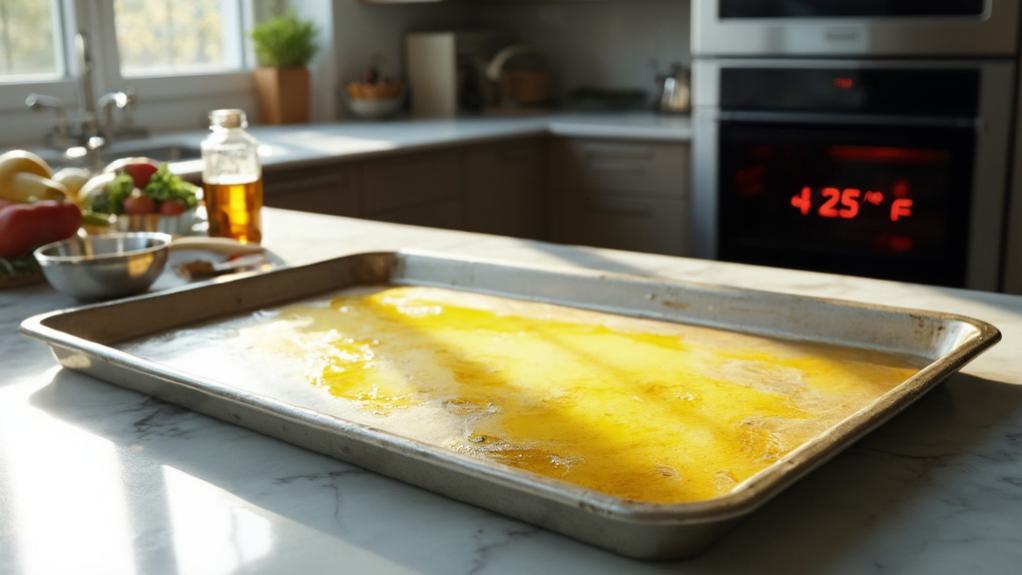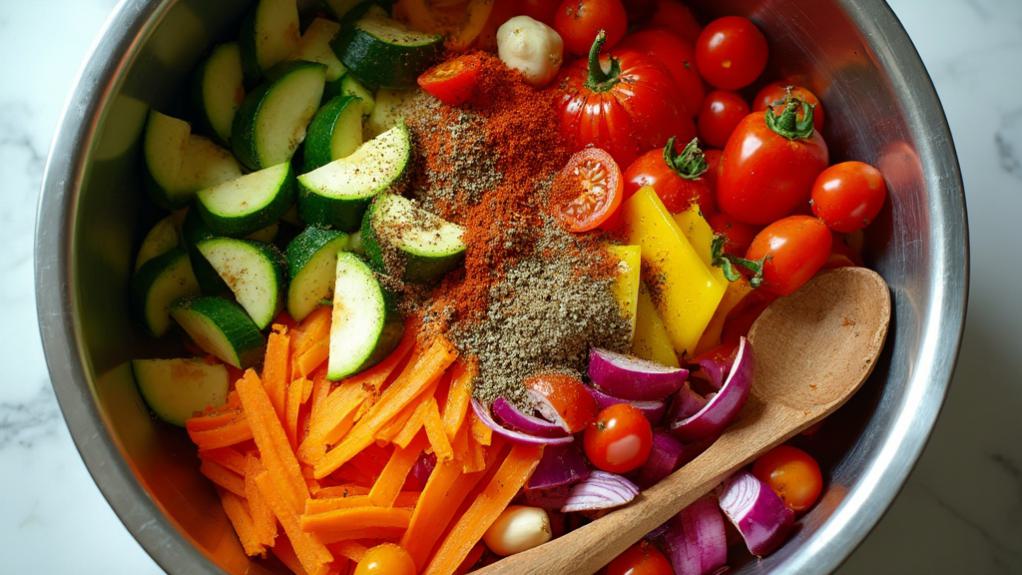I’ve discovered that the key to elevating a simple couscous dish lies in the patient art of roasting vegetables. When I’m crafting this Mediterranean-inspired meal in my kitchen, I’m always struck by how the gentle caramelization transforms ordinary vegetables into something extraordinary.
The marriage of pearl couscous with perfectly roasted vegetables, kissed by olive oil and herbs, creates a dish that’s both refined and comforting. While the basic concept might seem straightforward, I’ve uncovered several techniques that make the difference between a good couscous dish and an exceptional one.
Recipe
Roasted vegetable couscous combines the heartiness of whole grains with the natural sweetness of oven-roasted vegetables, creating a satisfying and nutritious vegan meal. The vegetables caramelize in the oven, developing deep flavors that complement the light, fluffy texture of the couscous.
This Mediterranean-inspired dish requires minimal hands-on preparation while delivering maximum flavor impact. The combination of warm spices and fresh herbs enhances both the vegetables and the couscous, resulting in a colorful, aromatic dish that can serve as either a main course or a substantial side.
- 2 cups couscous
- 4 cups vegetable broth
- 1 zucchini, sliced
- 2 bell peppers, chopped
- 1 red onion, cut into wedges
- 2 carrots, cut into chunks
- 1 cup cherry tomatoes
- 4 garlic cloves, whole
- 3 tablespoons olive oil
- 1 teaspoon cumin
- 1 teaspoon paprika
- 1 teaspoon dried oregano
- Salt and pepper to taste
- Fresh parsley for garnish
Preheat the oven to 425°F (220°C). Toss the prepared vegetables with olive oil, cumin, paprika, oregano, salt, and pepper in a large bowl. Spread them evenly on a baking sheet and roast for 25-30 minutes, stirring halfway through.
While the vegetables roast, bring the vegetable broth to a boil in a large pot. Add the couscous, remove from heat, cover, and let stand for 5 minutes. Fluff the couscous with a fork, fold in the roasted vegetables, and garnish with fresh parsley before serving.
For optimal results, ensure all vegetables are cut to similar sizes for even cooking. If the couscous appears dry, drizzle with additional olive oil before serving. Let the vegetables develop some charred edges in the oven for maximum flavor, but watch carefully to prevent burning.
The dish can be stored in an airtight container for up to three days in the refrigerator and can be served either hot or at room temperature.
Step-By-Step Cooking Instructions
You’ll want to begin by chopping your vegetables into uniform pieces and preheating your oven while coating your baking sheet with a thin layer of olive oil.
Next, you’ll toss your vegetables with the seasonings before spreading them on the pan, while simultaneously bringing your broth to a boil for the couscous.
Once everything’s cooked to perfection, you’ll combine the fluffy couscous with the roasted vegetables and finish with a generous sprinkle of fresh parsley.
Step 1. Chop All Vegetables Uniformly

For successful roasted vegetables, begin by cutting each piece to a uniform 1-inch size, ensuring even cooking throughout.
Start with your zucchini, slicing it into half-moons that’ll roast evenly and maintain their shape. Quarter your bell peppers lengthwise, remove the seeds and membranes, then cut them into consistent chunks that’ll caramelize beautifully in the oven.
Take your red onion and slice it through the root end into eight equal wedges, keeping the layers intact. For the carrots, angle your knife at 45 degrees to create elegant diagonal chunks that’ll cook at the same rate as your other vegetables.
Leave your cherry tomatoes whole – they’ll burst naturally during roasting, creating pockets of concentrated flavor throughout your dish.
When it comes to the garlic cloves, you’ll want to leave them whole but gently crushed with the flat of your knife. This releases their oils while preventing them from burning during the roasting process.
As you work, keep checking your pieces against each other to maintain that crucial 1-inch standard – it’s the key to achieving perfectly roasted vegetables that’ll complement your fluffy couscous.
Step 2. Preheat and Oil Pan

Every successful roasting begins with proper preheating, so start by setting your oven to 425°F (220°C) and allowing it to fully heat while you prepare a large rimmed baking sheet.
While your oven preheats, drizzle 2 tablespoons of olive oil across your baking sheet, ensuring even coverage.
You’ll want to use a sheet that’s large enough to accommodate your vegetables without overcrowding them – a 18×13-inch rimmed baking sheet works perfectly. If you’re doubling the recipe, you’ll need two sheets to maintain proper spacing.
The oil serves two crucial purposes: it prevents the vegetables from sticking and helps create that desirable caramelized exterior.
For enhanced flavor, you can infuse your oil with a crushed garlic clove or fresh herbs before coating the pan.
Don’t skimp on the oil, as too little will result in vegetables that stick and dry out during roasting.
If you’re using a older baking sheet that tends to stick, consider laying down a sheet of parchment paper first, then oiling it.
This extra step will ensure your roasted vegetables release easily while maintaining that perfect golden-brown finish.
Step 3. Toss Vegetables With Seasoning

Now that your baking sheet is properly prepared, it’s time to focus on seasoning your vegetables to perfection. In a large mixing bowl, combine your sliced zucchini, chopped bell peppers, red onion wedges, carrot chunks, whole cherry tomatoes, and unpeeled garlic cloves. Drizzle three tablespoons of olive oil over the medley, ensuring each piece will roast to a golden finish.
Sprinkle the cumin, paprika, and dried oregano evenly across your vegetables, followed by a generous pinch of salt and fresh-cracked black pepper. Using clean hands or wooden spoons, gently toss the vegetables until they’re uniformly coated with oil and seasonings.
You’ll want each piece to glisten with the aromatic mixture, as this ensures even flavor distribution during roasting. Work deliberately but quickly, as you don’t want the vegetables sitting in salt for too long before roasting.
Once you’re satisfied with the coating, transfer your seasoned vegetables onto your prepared baking sheet, arranging them in a single layer. Take care not to overcrowd the pan, as this will allow proper air circulation and ensure optimal caramelization.
Step 4. Boil Broth for Couscous

While your vegetables are roasting in the oven, turn your attention to preparing the perfect couscous base.
Pour four cups of vegetable broth into a medium-sized saucepan and place it over high heat. You’ll want to bring the broth to a vigorous boil, which typically takes about 5-7 minutes.
Watch for the telltale signs of boiling: rapid bubbles breaking the surface and steam rising steadily from the pot. Once you’ve achieved a rolling boil, remove the saucepan from heat immediately.
Add your two cups of dry couscous to the hot broth, giving it a quick stir to ensure all the grains are submerged. Cover the pot tightly with a lid or aluminum foil to trap the steam.
Let the covered couscous stand undisturbed for exactly five minutes – this precise timing is crucial for achieving the ideal texture.
During this time, the tiny semolina spheres will absorb the hot broth and steam to perfection. Don’t lift the lid during this process, as you’ll want to maintain consistent temperature and steam levels for even cooking.
Step 5. Garnish and Serve Hot

After your couscous has absorbed the broth, uncover the pot to reveal perfectly steamed grains ready for assembly.
Using a fork, gently fluff the couscous to separate any clumps and create a light, airy texture. Transfer the fluffy grains to a large serving platter or bowl, creating a generous bed for your roasted vegetables.
Arrange the caramelized vegetables atop the couscous, distributing them evenly to ensure each serving captures the full medley of colors and flavors.
Drizzle any remaining oil and roasting juices from the baking sheet over the dish to enhance its richness. Finely chop fresh parsley and scatter it generously across the top, allowing the bright green herbs to contrast beautifully with the golden couscous and vibrant vegetables.
For an extra touch of Mediterranean flair, you’ll want to finish with a light drizzle of premium olive oil and a final seasoning of freshly ground black pepper.
Serve immediately while the dish is still warm, allowing your guests to appreciate the perfect harmony of tender vegetables and fragrant couscous.
Don’t forget to place additional fresh herbs at the table for those who desire extra garnish.
Why I Love This Dish
This Mediterranean-inspired dish holds a special place in my heart for its remarkable versatility and vibrant flavors. I’m continually amazed by how the simple combination of roasted vegetables and fluffy couscous creates such a satisfying meal that works beautifully for both casual weeknight dinners and elegant entertaining.
What I cherish most about this dish is its adaptability to any season. In summer, I’ll load it with zucchini and tomatoes from my garden, while autumn calls for hearty root vegetables and winter squash. The caramelization that occurs during roasting transforms even the most humble vegetables into something extraordinary, creating deep, complex flavors that perfectly complement the light, nutty couscous.
I’ve found this dish to be my reliable solution for meal prep, as it tastes wonderful both hot and cold. When I’m hosting guests with dietary restrictions, it’s my go-to recipe – it’s naturally vegan, can be made gluten-free with quinoa, and feels substantial enough to serve as a main course.
The way the vegetables’ natural sweetness develops in the roasting process never fails to impress my dinner guests.

Leave a Reply